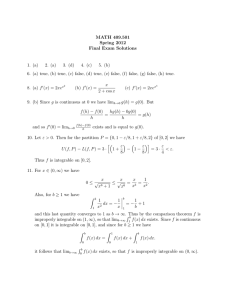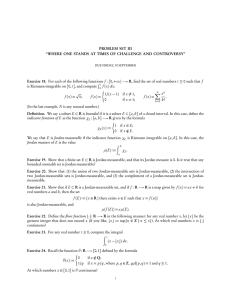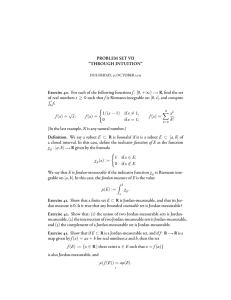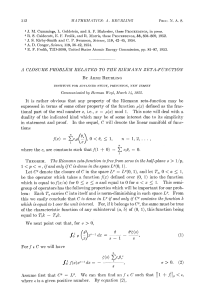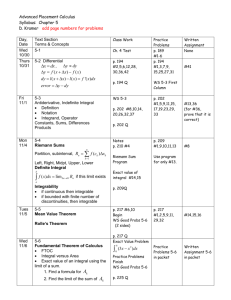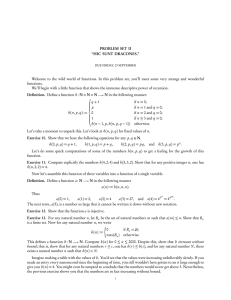MATH 311 Topics in Applied Mathematics I Lecture 32: More on the differential.
advertisement
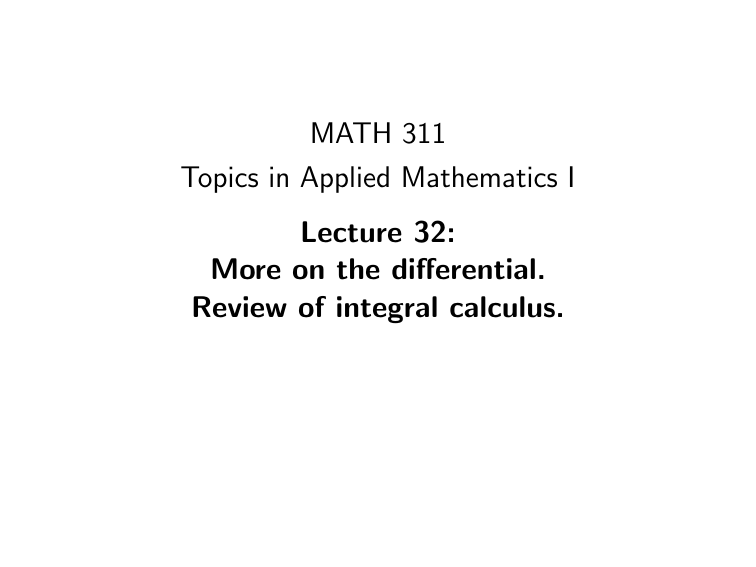
MATH 311
Topics in Applied Mathematics I
Lecture 32:
More on the differential.
Review of integral calculus.
The differential
Suppose V and W are normed vector spaces and consider a
function F : X → V , where X ⊂ W .
Definition. We say that the function F is differentiable at a
point a ∈ X if it is defined in a neighborhood of a and there
exists a continuous linear transformation L : W → V such
that
F (a + v) = F (a) + L(v) + R(v),
where kR(v)k/kvk → 0 as kvk → 0. The transformation L
is called the differential of F at a and denoted (DF )(a).
Remarks. • A linear transformation L : W → V is
continuous if and only if kL(v)k ≤ C kvk for some C > 0 and
all v ∈ W .
• If dim W < ∞ then any linear transformation L : W → V
is continuous. Otherwise it is not so.
Examples
• Any linear transformation L : R → R is a scaling
L(x) = rx by a scalar r . If L is the differential of a function
f : X → R at a point a ∈ R, then r = f 0 (a).
• Any linear transformation L : Rn → Rm is a matrix
transformation: L(x) = Bx, where B = (bij ) is an m×n
matrix. If L is the differential of a function F : X → Rm at
∂Fi
a point a ∈ Rn , then bij =
(a).
∂xj
The matrix B of partial derivatives is called the Jacobian
∂(F1 , . . . , Fm )
.
matrix of F and denoted
∂(x1 , . . . , xn )
Riemann sums and Riemann integral
Definition. A Riemann sum of a function f : [a, b] → R
with respect to a partition P = {x0 , x1, . . . , xn } of [a, b]
generated by samples tj ∈ [xj−1 , xj ] is a sum
Xn
f (tj ) (xj − xj−1 ).
S(f , P, tj ) =
j=1
Remark. P = {x0 , x1 , . . . , xn } is a partition of [a, b] if
a = x0 < x1 < · · · < xn−1 < xn = b. The norm of the
partition P is kPk = max1≤j≤n |xj − xj−1 |.
Definition. The Riemann sums S(f , P, tj ) converge to a limit
I (f ) as the norm kPk → 0 if for every ε > 0 there exists
δ > 0 such that kPk < δ implies |S(f , P, tj ) − I (f )| < ε for
any partition P and choice of samples tj .
If this is the case, then the function f is called integrable on
[a, b] and the limit I (f ) is called the integral of f over [a, b],
Rb
denoted a f (x) dx.
Riemann sums and Darboux sums
x0
x1
x2
x3
x4
x0 t1
x1 t2
x2 t3 x3 t4 x4
Integration as a linear operation
Theorem 1 If functions f , g are integrable on an
interval [a, b], then the sum f + g is also
integrable on [a, b] and
Z b
Z b
Z b
f (x) + g (x) dx =
f (x) dx +
g (x) dx.
a
a
a
Theorem 2 If a function f is integrable on [a, b],
then for each α ∈ R the scalar multiple αf is also
integrable on [a, b] and
Z b
Z b
αf (x) dx = α
f (x) dx.
a
a
More properties of integrals
Theorem If a function f is integrable on [a, b] and
f ([a, b]) ⊂ [A, B], then for each continuous function
g : [A, B] → R the composition g ◦ f is also integrable on
[a, b].
Theorem If functions f and g are integrable on [a, b], then
so is fg .
Theorem If a function f is integrable on [a, b], then it is
integrable on each subinterval [c, d ] ⊂ [a, b]. Moreover, for
any c ∈ (a, b) we have
Z b
Z c
Z b
f (x) dx =
f (x) dx +
f (x) dx.
a
a
c
Comparison theorems for integrals
Theorem 1 If functions f , g are integrable on
[a, b] and f (x) ≤ g (x) for all x ∈ [a, b], then
Z b
Z b
f (x) dx ≤
g (x) dx.
a
a
Theorem 2 If f is integrable on [a, b] and
Z b
f (x) ≥ 0 for x ∈ [a, b], then
f (x) dx ≥ 0.
a
Theorem 3 If f is integrable on [a, b], then the
function |f | is also integrable on [a, b] and
Z b
Z b
≤
|f (x)| dx.
f
(x)
dx
a
a
Fundamental theorem of calculus
Theorem If a function f is continuous on an
interval [a, b], then the function
Z x
F (x) =
f (t) dt, x ∈ [a, b],
a
is continuously differentiable on [a, b]. Moreover,
F 0 (x) = f (x) for all x ∈ [a, b].
Theorem If a function F is differentiable on [a, b]
and the derivative F 0 is integrable on [a, b], then
Z b
F 0 (x) dx = F (b) − F (a).
a
Change of the variable in an integral
Theorem If φ is continuously differentiable on a closed,
nondegenerate interval [a, b] and f is continuous on
φ([a, b]), then
Z φ(b)
Z b
Z b
0
f (t) dt =
f (φ(x)) φ (x) dx =
f (φ(x)) d φ(x).
φ(a)
a
a
Remarks. • It is possible that φ(a) ≥ φ(b). To make sense
of the integral in this case, we set
Z d
Z c
f (t) dt = −
f (t) dt
c
d
if c > d . Also, we set the integral to be 0 if c = d .
• t = φ(x) is a proper change of the variable only if the
function φ is strictly monotone. However the theorem holds
even without this assumption.
Sets of measure zero
Definition. A subset E of the real line R is said to have
measure zero if for any ε > 0 the set E can be covered by a
sequence
of open intervals J1 , J2 , . . . such that
P∞
n=1 |Jn | < ε.
Examples. • Any set E that can be represented as a sequence
x1 , x2 , . . . (such sets are called countable) has measure zero.
Indeed, for any ε > 0, let
ε
ε Jn = xn − n+1 , xn + n+1 , n = 1, 2, . . .
2
2
Then P
E ⊂ J1 ∪ J2 ∪ . . . and |Jn | = ε/2n for all n ∈ N so
∞
that
n=1 |Jn | = ε.
• The set Q of rational numbers has measure zero (since it is
countable).
• Nondegenerate interval [a, b] is not a set of measure zero.
Lebesgue’s criterion for Riemann integrability
Definition. Suppose P(x) is a property depending
on x ∈ S, where S ⊂ R. We say that P(x) holds
for almost all x ∈ S (or almost everywhere on
S) if the set {x ∈ S | P(x) does not hold } has
measure zero.
Theorem A function f : [a, b] → R is Riemann
integrable on the interval [a, b] if and only if f is
bounded on [a, b] and continuous almost
everywhere on [a, b].
Area, volume, and determinants
• 2×2 determinants and plane geometry
Let P be a parallelogram in the plane R2 . Suppose that
vectors v1 , v2 ∈ R2 are represented by adjacent sides of P.
Then area(P) = |det A|, where A = (v1 , v2 ), a matrix whose
columns are v1 and v2 .
Consider a linear operator LA : R2 → R2 given by
LA (v) = Av for any column vector v. Then
area(LA (D)) = |det A| area(D) for any bounded domain D.
• 3×3 determinants and space geometry
Let Π be a parallelepiped in space R3 . Suppose that vectors
v1 , v2 , v3 ∈ R3 are represented by adjacent edges of Π. Then
volume(Π) = |det B|, where B = (v1 , v2 , v3 ), a matrix whose
columns are v1 , v2 , and v3 .
Similarly, volume(LB (D)) = |det B| volume(D) for any
bounded domain D ⊂ R3 .
v1
v3
v2
volume(Π) = |det B|, where B = (v1 , v2 , v3 ). Note that the
parallelepiped Π is the image under LB of a unit cube whose
adjacent edges are e1 , e2 , e3 .
The triple v1 , v2 , v3 obeys the right-hand rule. We say that
LB preserves orientation if it preserves the hand rule for any
basis. This is the case if and only if det B > 0.

